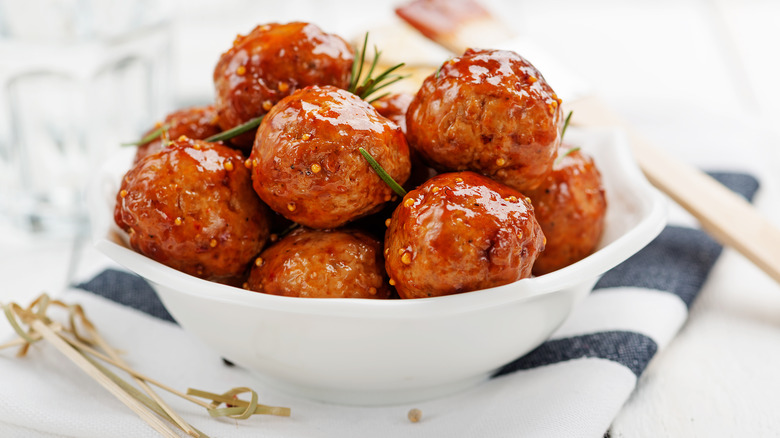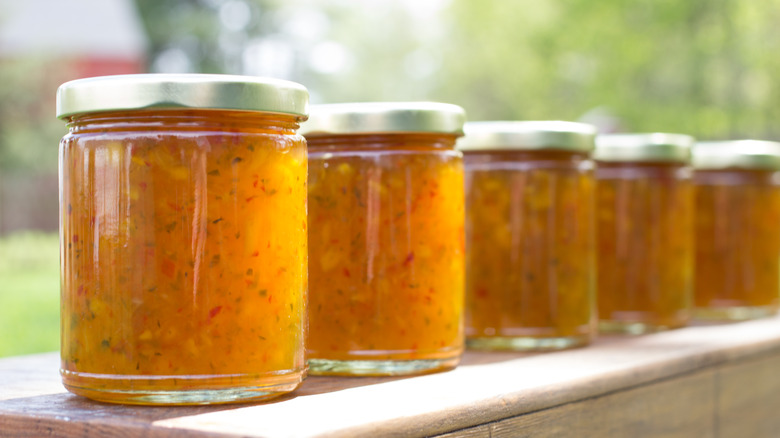Pepper Jelly Is The Perfect Sweet And Spicy Glaze For Meatballs
Meatballs are made for more than just spaghetti but they do need a little something extra to be able to stand alone. By giving meatballs a boost of striking and distinctive flavor they can hold their own as hors d'oeuvres or a main or side dish. This is where the right glaze can make a world of difference. What better way is there to elevate the flavor profile of a humble meatball than with a sweet and spicy glaze that has you licking your lips and reaching for more?
And this is where pepper jelly comes in. Not only is it the perfect texture for a glaze, but the combination of flavors is ideal for amping up the simpler flavors of meatballs and turning them into something special. Together, the sweet and spicy notes in pepper jelly strike that perfect balance you're looking for in a meatball glaze. While the pepper burns, the sweetness acts to even it out. Although generic grape jelly might be a traditional way to glaze meatballs, pepper jelly kicks that glaze up a notch and gives you a meatball with the right equilibrium of delectable flavors.
Pepper jelly plays well with others
Your local grocer will likely carry a selection of pepper jellies, and of course, there are plenty available online. Flavors range from mild red pepper to kicky habanero, and include chipotle, mango, and even pomegranate. If you want to experiment with making pepper jelly yourself, go for it! Some recipes take less than an hour to put together — but most pepper jellies need at least 24 hours to set. Using pre-made pepper jelly cuts way down on the overall cooking time.
Pepper jelly should be mixed with other sauces and seasonings to give meatballs a well-rounded flavor profile, but the jelly should be the predominant ingredient. It is the star of this show, after all. Add any additional sauces and seasonings to taste. The most common sauce to combine with pepper jelly for a meatball glaze is barbecue sauce; chili sauce and Dijon mustard can also be used.
Some people like to add beer or broth as well, for their umami effects. Keep in mind thinner liquids need a bit of cornstarch to thicken into a glaze if they are used as the base. Cayenne pepper, chili powder, or red pepper flakes will turn the heat up another notch. And it's hard to go wrong with a little bit of garlic powder. Once all of your selected ingredients are combined, give the glaze a quick simmer before adding to your meatballs. You can then cook the meatballs in your slow cooker or oven.
Pepper jelly versus pepper jam
Pepper jelly and pepper jam are both excellent choices for many applications, so you may wonder if you can use pepper jam in your meatball glaze instead of pepper jelly. However, there is an important distinction between the two that makes the jelly a much better choice. As with other types of jams, pepper jam will have actual fruit chunks in it. Pepper jelly, on the other hand, is made from fruit juice so it won't have any chunks or pulp in it.
The smoother consistency of the jelly means that it is far superior to a jam when it comes to making a glaze for meatballs. Although spicy jam often goes great on top of cooked meats and soft cheeses, jam's chunkier texture isn't really what you're going for with a meatball glaze — especially if there are seeds involved. You'll want to save that jam to use as a condiment and pick up a fresh jar of pepper jelly the next time you have a hankering for meatballs with a kick.


